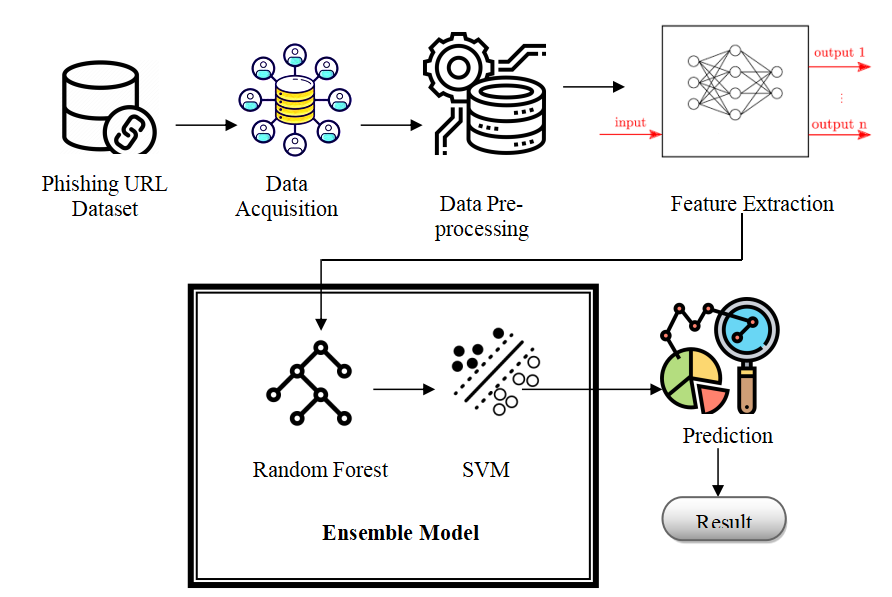Develop a Hybrid Classification using an Ensemble Model for Phishing Website Detection
Main Article Content
Abstract
Solutions to threats posed by technical and social vulnerabilities must be found to secure the web interface. Social engineering attacks frequently use phishing as one of their vectors. The importance is promptly detecting phishing attacks has increased. The classifier model was constructed using publicly accessible data from trustworthy and phishing websites. A variety of methods were used to extract relevant features to build the model. Before a user experiences any harm, Machine Learning algorithms can reliably identify phishing attacks. To identify phishing attacks on the website, this study presents a novel ensemble model. In this paper, the Artificial Neural Network (ANN) and the Random Forest Classifier (RFC) are used in an ensemble method along with the Support Vector Machine (SVM). Compared to previous studies, this ensemble method more accurately and efficiently detects website phishing attacks. According to experimental findings, the proposed system detects phishing attacks 97.3% of the time.
Article Details
References
Kalabarige, L. R., Rao, R. S., Abraham, A., &Gabralla, L. A. (2022). Multilayer stacked ensemble learning model to detect phishing websites. IEEE Access, 10, 79543-79552.DOI: 10.1109/ACCESS.2022.3194672
Alsariera, Y. A., Balogun, A. O., Adeyemo, V. E., Tarawneh, O. H., &Mojeed, H. A. (2022). Intelligent tree-based ensemble approaches for phishing website detection. J. Eng. Sci. Technol, 17, 563-582. https://doi.org/10.3390/math9212799
Atre, M., Jha, B., & Rao, A. (2022). Detecting Cloud-Based Phishing Attacks by Combining Deep Learning Models. arXiv preprint arXiv:2204.02446.https://doi.org/10.48550/arXiv.2204.02446
Puri, N., Saggar, P., Kaur, A., & Garg, P. (2022, July). Application of ensemble Machine Learning models for phishing detection on web networks. In 2022 Fifth International Conference on Computational Intelligence and Communication Technologies (CCICT) (pp. 296-303). IEEE.DOI:10.1109/INMIC50486.2020.9318210
Hota, H. S., Shrivas, A. K., &Hota, R. (2018). An ensemble model for detecting phishing attacks with proposed remove-replace feature selection technique. Procedia computer science, https://doi.org/10.1016/j.procs.2018.05.103
Bidabadi, F. S., & Wang, S. (2022). A new weighted ensemble model for phishing detection based on feature selection. arXiv preprint arhttps://doi.org/10.48550/arXiv.2212.11125Xiv:2212.11125.
Balamurugan, K., Latchoumi, T. P., &Ezhilarasi, T. P. (2022). Wearables to Improve Efficiency, Productivity, and Safety of Operations. In Smart Manufacturing Technologies for Industry 4.0 (pp. 75-90). CRC PressDOI:10.1201/9781003186670-9
Mohan, A., Prabha, G. ., & V., A. . (2023). Multi Sensor System and Automatic Shutters for Bridge- An Approach. International Journal of Intelligent Systems and Applications in Engineering, 11(4s), 278–281. Retrieved from https://ijisae.org/index.php/IJISAE/article/view/2665
Hossain, F., Islam, L., & Uddin, M. N. (2022, September). PhishRescue: A Stacked Ensemble Model to Identify Phishing Website Using Lexical Features. In 2022 5th International Conference of Computer and Informatics Engineering (IC2IE) (pp. 342-347). DOI: 10.1109/IC2IE56416.2022.9970179
Garikapati, P., Balamurugan, K., & Latchoumi, T. P. (2022). K-means partitioning approach to predict the error observations in small datasets. International Journal of Computer Aided Engineering and Technology, 17(4), 412-430.https://doi.org/10.1504/IJCAET.2022.126601
Livara, A., & Hernandez, R. (2022, January). An Empirical Analysis of Machine Learning Techniques in Phishing E-mail detection. In 2022 International Conference for Advancement in Technology (ICONAT) (pp. 1-6). IEEE.DOI: 10.1109/ICONAT53423.2022.9725434
Ansari, M. F., Panigrahi, A., Jakka, G., Pati, A., & Bhattacharya, K. (2022, November). Prevention of Phishing attacks using AI Algorithm. In 2022 2nd Odisha International Conference on Electrical Power Engineering, Communication and Computing Technology (ODICON) (pp. 1-5). IEEE.DOI: 10.1109/ODICON54453.2022.10010185
Pandey, M. K., Singh, M. K., Pal, S., & Tiwari, B. B. (2022). Prediction of Phishing Websites Using Stacked Ensemble Method and Hybrid Features Selection Method. SN Computer Science, 3(6), 488.DOI:10.1007/s42979-022-01387-4
Prof. Barry Wiling. (2017). Monitoring of Sona Massori Paddy Crop and its Pests Using Image Processing. International Journal of New Practices in Management and Engineering, 6(02), 01 - 06. https://doi.org/10.17762/ijnpme.v6i02.54
Latchoumi, T. P., Swathi, R., Vidyasri, P., & Balamurugan, K. (2022, March). Develop New Algorithm To Improve Safety On WMSN In Health Disease Monitoring. In 2022 International Mobile and Embedded Technology Conference (MECON) (pp. 357-362). IEEE.DOI: 10.1109/MECON53876.2022.9752178
ShiraniBidabadi, F., & Wang, S. (2022). A new weighted ensemble model for phishing detection based on feature selection. arXiv e-prints, arXiv-2212.https://doi.org/10.48550/arXiv.2212.11125
Bhowmik, P., & Bhowmik, P. C. (2022, October). A Machine Learning Approach for Phishing Websites Prediction with Novel Feature Selection Framework. In Proceedings of International Conference on Fourth Industrial Revolution and Beyond 2021 (pp. 357-370). Singapore: Springer Nature Singapore.DOI:10.1007/978-981-19-2445-3_24
Shaaban, M. A., Hassan, Y. F., &Guirguis, S. K. (2022). Deep convolutional forest: a dynamic deep ensemble approach for spam detection in text. Complex & Intelligent Systems, 1-13.https://doi.org/10.1007/s40747-022-00741-6
Thomas Wilson, Andrew Evans, Alejandro Perez, Luis Pérez, Juan Martinez. Machine Learning for Anomaly Detection and Outlier Analysis in Decision Science. Kuwait Journal of Machine Learning, 2(3). Retrieved from http://kuwaitjournals.com/index.php/kjml/article/view/207
Catal, C., Giray, G., Tekinerdogan, B., Kumar, S., & Shukla, S. (2022). Applications of deep learning for phishing detection: a systematic literature review. Knowledge and Information Systems, 1-44.https://doi.org/10.1007/s10115-022-01672-x
Balamurugan, K., Latchoumi, T. P., &Ezhilarasi, T. P. (2022). Wearables to Improve Efficiency, Productivity, and Safety of Operations. In Smart Manufacturing Technologies for Industry 4.0 (pp. 75-90). CRC Press.DOI:10.1201/9781003186670-9
Mithra Raj, M., & Arul Jothi, J. A. (2022, October). Website Phishing Detection Using Machine Learning Classification Algorithms. In Applied Informatics: 5th International Conference, ICAI 2022, Arequipa, Peru, October 27–29, 2022, Proceedings (pp. 219-233). Cham: Springer International Publishing.DOI:10.1007/978-3-031-19647-8_16
Shmalko, M., Abuadbba, A., Gaire, R., Wu, T., Paik, H. Y., & Nepal, S. (2022). Profiler: Profile-Based Model to Detect Phishing Emails. arXiv preprint arXiv:2208.08745.https://doi.org/10.48550/arXiv.2208.08745
Rao, R. S., Umarekar, A., &Pais, A. R. (2022). Application of word embedding and machine learning in detecting phishing websites. Telecommunication Systems, 79(1), 33-45.https://doi.org/10.1007/s11235-021-00850-6
Almousa, M., Furst, R., & Anwar, M. (2022, September). Characterizing Coding Style of Phishing Websites Using Machine Learning Techniques. In 2022 Fourth International Conference on Transdisciplinary AI (TransAI) (pp. 101-105). IEEE.DOI:10.1109/TransAI54797.2022.00025
Rathee, D., & Mann, S. (2022). Detection of E-mail phishing attacks–using machine learning and deep learning. International Journal of Computer Applications, 183(1), 7
DOI: 10.1109/ICCES54183.2022.9835846

